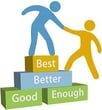Best Suggestive Selling Techniques To Increase Retail Sales

What is suggestive selling?
Suggestive selling is the key to building great customer service and hitting sales goals. Suggestive selling is how retailers entice customers to buy more through a well-merchandised display or sales associate interactions.
Retailers who have a robust training program focus on suggestive selling. It is something every employee can do to raise the average ticket and number of items, also improving the customer experience.
However, adding on becomes a problem without a retail sales training program. Employees are expected to do it without being brought into the concept and given the tools to execute well.
But those retailers who have learned the art of effective suggestive selling and the science of customer service can maximize a customer's visit.
Benefits of successful suggestive selling
When visiting a store, customers often have only one item in mind. Unless a salesperson suggests an additional product, the customer will leave without having everything they could have purchased. There could have been an item they wanted but didn't know of or an item that complemented their original purchase, but they failed to spot it.
Once customers have decided to purchase an item, it is easier for them to say yes again to an additional item. All of the work to engage a stranger, develop rapport, and become a trusted advisor pays off in the additional sale.
The more items going out the door due to your employees’ effective sales efforts, the higher your store profits...and the better you’ll hold up against the online bandits.
Instead of associates having time to stand around gazing at their smartphones, they use more time per shopper to create exceptional experiences.
The key to a suggestive selling strategy is being invitational rather than pushy
For example, two friends are shopping at your gift store. After the first one has decided on an item, your associate should be trained to turn to the friend and say, “So now let’s get something for you.”
Will it work every time? Of course not.
However, using suggestive selling and inviting someone to purchase additional items each time increases your chances of increasing your sales. And while all evidence shows that store visits are most profitable, don’t forget about curbside pickup and your online site.
5 suggestive selling techniques
1. Question
The time to begin talking about adding on is during the sale. So, when the shopper asks about the durability of your footwear or how to take care of it, we call those buying signs.
You would follow up with, “How do you take care of your shoes now?” When they answer, you reply, “I have some ideas for what can help you that I’ll share at the end if that’s okay.” Again, invitational works better.
2. Confirm curbside orders by phone
The convenience of curbside delivery can be tempting, as shown by this Twitter user who raved about picking up his order on his bike.
I love it that @Target lets you identify that you're doing curbside pickup by bike. Turned on the GPS option so they could see that I was coming and they were literally waiting for me at the curb. Only stopped for 7 seconds. So easy. #LeaveTheCarAtHome pic.twitter.com/XvW52FHi44
— Allen Cowgill (@AllenCowgill) August 24, 2020
But one of the greatest margin sucks for brick-and-mortar retail is curbside delivery because it minimizes exposure to your great merchandising or retail staff.
To combat this, upon receiving an order, call, or text in return with a simple message, customers who purchase that often find they need a few other items. May I suggest them to you? Once they say yes, you can suggestively mention three specific items related to the product they purchased.
3. Paint a stressful picture
This can work for almost any product. Once the customer has locked onto the main item, simply describe a common frustration previous customers have encountered after leaving the store. Begin with, "Have you ever…?"
For example, a man is buying a couple of gallons of paint and has decided on the color. You could say, “Have you ever gotten home with paint and couldn’t find the right brush to use?” Wait for them to say yes. Then continue, "We have the right ones over here."
4. Don’t forget merchandising
Displays are your silent salespeople. While more passive than an associate engagement, showing items from other departments with different price points is a smart way to merchandise.
In-store, Nordstrom has been known to feature snazzy Comme des Garçons sneakers with other brands from other departments to encourage requests for the add-on.
5. Feature online add-on suggestions
Amazon masters this with their "People who bought this, bought this." Other online retailers use their brand’s voice to communicate the same point. Phrases like “Complete the look", Looks great with", "Often Bought With,” and “Don’t forget these” encourage customers to buy more.
But let’s face it. Many retail employees push back on suggestive selling and even get pleasure from doing it with a cynical attitude.
Oh those types have a weakness, a statement that means you think less of them than they do themselves. For example, "I think these are in YOUR price range?" and show him the cheaper pens. It's technically suggestive selling and it lets you be snide. :)
— Laporkra (@Laporkra)
That is what happens when you don’t get buy-in from your retail sales staff.
3 tips for getting associates to use suggestive selling
1. Share a bad purchase memory
We’ve all had a bad experience where we purchased one thing we needed but left the store without the add-ons we needed: think batteries for a toy, potting soil for a plant, a belt for a suit – you get the idea.
During a training session, have each associate share their own story. Ask how it made them feel. Then, ask them to think about what their salesperson should have done.
This gets them to see suggestively selling and cross-selling as a service to a customer, not something sales-y.
2. Make time with a customer priority
Associates don’t upsell because they assume people just want to get in and out. While there’s a bit of truth, it isn’t the whole truth.
And while some retailers have been slammed with a demand that made them sell defensively and just get the shopper something, you most want to upsell when there is high demand. So don’t let employees say they don’t have time to upsell; it will cost you profit.
3. Have them sell a sale item as an add-on
So many retailers have abandoned any retail sales training and have left employees to do their jobs without training. That often means they sell from their own wallet, pointing out the sale items as a good value and leaving the full-priced merchandise languishing.
To get them to sell suggestively, train them to sell the full-priced merchandise first and then invite the customer to follow them for a sale item that is of great value.
Mistakes that limit your ability to sell suggestively successfully
Giving a laundry list of products
Sometimes, associates go overboard with add-on suggestions. They don’t suggestively sell just one thing; they give shoppers a laundry list of things to buy.
This overwhelms the customer, breaks their trust in you, and shuts them down to getting anything more than what they came for.
Asking 'anything else?'
Once a shopper has decided to purchase, their minds have switched to their next task, or they’ve picked up their smartphones.
They will instinctively answer your boring, "Anything else?" with No – even if they need something because, like Elvis, they have mentally left the building.
See also: Best Suggestive Selling Tips and Techniques for Luxury Retail Stores
Suggestive selling is trainable but not on its own
Suggestively selling merchandise isn’t brain surgery, but it does require training.
Getting associates comfortable with the extra few minutes it takes to engage with the shopper and give them a fuller solution to what they came in the door for is required, as is understanding how adding on helps rather than hurts.
I have a full course on selling more to grow your retail sales, and suggestive selling is just one of many proven selling techniques. You can find out more about SalesRX.com, my online learning platform, here.
Use the tips above to unlock the power of suggestive selling.
Take my free 5-part email course to learn how your retail store can outsell any online retailer. You can begin your first lesson by entering your name and email address below ...



